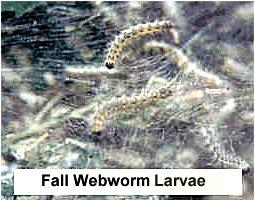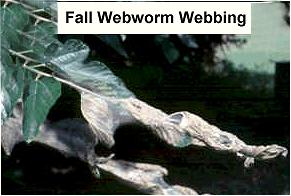|
 Fall
webworm feeds on almost all fruit, shade, and ornamental trees except
conifers. This insect is present more often on trees that are not
surrounded by other trees. The larvae begin by constructing small
webs near the ends of branches. The insect will gradually increase
the size of the web as the need for food increases. Mature
caterpillars are yellowish with black and brown markings, and have many
tufts of long hair. As larvae mature, they crawl down the tree and
spend the winter as pupa in the leaf litter under the tree. Fall
webworm feeds on almost all fruit, shade, and ornamental trees except
conifers. This insect is present more often on trees that are not
surrounded by other trees. The larvae begin by constructing small
webs near the ends of branches. The insect will gradually increase
the size of the web as the need for food increases. Mature
caterpillars are yellowish with black and brown markings, and have many
tufts of long hair. As larvae mature, they crawl down the tree and
spend the winter as pupa in the leaf litter under the tree.
 High
populations of fall webworm can completely defoliate host plants but do
not kill them. Pruning and destroying the infested portions of
branches is a common control practice while webs are still small.
Also, a stick or pole with a nail inserted crosswise can be used to snag
individual webs. Twisting the pole after insertion will cause the
web to wrap around the pole where it can be removed and destroyed.
Insecticides can also be used for control but a commercial quality, high
pressure sprayer is needed to penetrate the webs. We are late enough
in the season that control is not needed to protect the health of the
tree. High
populations of fall webworm can completely defoliate host plants but do
not kill them. Pruning and destroying the infested portions of
branches is a common control practice while webs are still small.
Also, a stick or pole with a nail inserted crosswise can be used to snag
individual webs. Twisting the pole after insertion will cause the
web to wrap around the pole where it can be removed and destroyed.
Insecticides can also be used for control but a commercial quality, high
pressure sprayer is needed to penetrate the webs. We are late enough
in the season that control is not needed to protect the health of the
tree.
Nuisance
of the Week Archives
Nuisance of the Week is brought to
you in cooperation with the Kansas
State University Research & Extension
Written by Ward Upham, Extension Associate
|

 Fall
webworm feeds on almost all fruit, shade, and ornamental trees except
conifers. This insect is present more often on trees that are not
surrounded by other trees. The larvae begin by constructing small
webs near the ends of branches. The insect will gradually increase
the size of the web as the need for food increases. Mature
caterpillars are yellowish with black and brown markings, and have many
tufts of long hair. As larvae mature, they crawl down the tree and
spend the winter as pupa in the leaf litter under the tree.
Fall
webworm feeds on almost all fruit, shade, and ornamental trees except
conifers. This insect is present more often on trees that are not
surrounded by other trees. The larvae begin by constructing small
webs near the ends of branches. The insect will gradually increase
the size of the web as the need for food increases. Mature
caterpillars are yellowish with black and brown markings, and have many
tufts of long hair. As larvae mature, they crawl down the tree and
spend the winter as pupa in the leaf litter under the tree.  High
populations of fall webworm can completely defoliate host plants but do
not kill them. Pruning and destroying the infested portions of
branches is a common control practice while webs are still small.
Also, a stick or pole with a nail inserted crosswise can be used to snag
individual webs. Twisting the pole after insertion will cause the
web to wrap around the pole where it can be removed and destroyed.
Insecticides can also be used for control but a commercial quality, high
pressure sprayer is needed to penetrate the webs. We are late enough
in the season that control is not needed to protect the health of the
tree.
High
populations of fall webworm can completely defoliate host plants but do
not kill them. Pruning and destroying the infested portions of
branches is a common control practice while webs are still small.
Also, a stick or pole with a nail inserted crosswise can be used to snag
individual webs. Twisting the pole after insertion will cause the
web to wrap around the pole where it can be removed and destroyed.
Insecticides can also be used for control but a commercial quality, high
pressure sprayer is needed to penetrate the webs. We are late enough
in the season that control is not needed to protect the health of the
tree.